19th ASEAN-India Summit
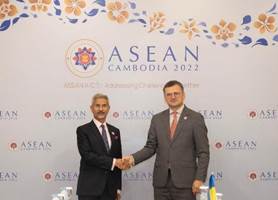
Disclaimer: Copyright infringement not intended.
Context
- The Association of South East Asian Nations (ASEAN) and India had the 19th Summit to commemorate the 30th Anniversary of ASEAN-India dialogue relations on November 12, 2022 in Phnom Penh, Cambodia.
ASEAN
- ASEAN officially the Association of Southeast Asian Nations, is a political and economic union of 10 member states in Southeast Asia.
- It promotes intergovernmental cooperation and facilitates economic, political, security, military, educational, and sociocultural integration between its members and countries in the Asia-Pacific.
- ASEAN was created on 8 August 1967

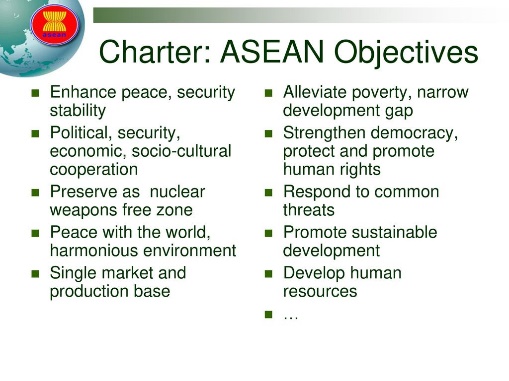
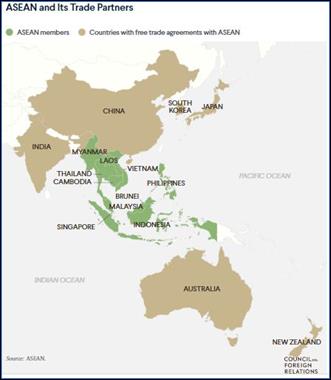
ASEAN India Relationship: A Brief Analysis
- ASEAN-India Relations India’s relationship with ASEAN has emerged as a key cornerstone of our foreign policy. The relationship has evolved from the ‘Look East Policy’ enunciated in early 1990s which led India to become a Sectoral Partner of ASEAN in 1992, a Dialogue Partner in 1996 and a Summit-level Partner in 2002.
- The relationship got upgraded to a Strategic Partnership during the celebration of 20th-anniversary Commemorative Summit at New Delhi in 2012.
- The India-ASEAN Strategic Partnership acquired a new momentum with the announcement of “Act-East Policy” in the 12th Summit in 2014.
- The Act-East Policy emphasizes Connectivity, Commerce, and Culture as the focus areas of action for a greater ASEAN-India integration.
- And now at the 19th India-ASEAN Summit, the relationship is now elevated to the Comprehensive Strategic Partnership (CSP) level.
Areas of Cooperation
Economic Cooperation:
- India-ASEAN trade and investment relations have been growing steadily, with ASEAN being India's fourth-largest trading partner.
- Ever since the signing of Free Trade Agreement in goods in 2009 with ASEAN, the bilateral trade between ASEAN-India has crossed US$ 80 billion marks which is approx. 10.6% of India's overall trade. India's export to ASEAN stands at 11.28% of our total exports.
Socio-Cultural Cooperation:
- ASEAN and India continue to organise regular programs/activities, namely - ASEAN-India Students Exchange Programmes, Special Course for ASEAN Diplomats, and Delhi Dialogue, International Conference on ASEAN-India Cultural and Civilizational Links, ASEAN-India Media Exchange Programme, ASEAN-India Young Farmers Exchange Programme, ASEAN-India Youth Summit and the ASEAN-India Network of Think-Tanks, among others.
Connectivity:
- India has made considerable progress in implementing the India-Myanmar-Thailand Trilateral Highway and the Kaladan Multimodal Project. ASEAN and India are transforming the corridors of connectivity into economic corridors.
- A consensus on finalizing the proposed protocol of the India Myanmar-Thailand Motor Vehicle Agreement (IMT MVA) has been reached.
- This agreement will have a critical role in realizing the seamless movement of passenger, personal and cargo vehicles along roads linking India, Myanmar and Thailand. India announced a Line of Credit of US$ 1 billion to promote projects that support physical and digital connectivity between India and ASEAN.
Tourism:
- India-ASEAN cooperation in Tourism Sector is conducted through annual ASEAN India Tourism Ministers Meeting.
- India is the first Dialogue Partner to sign an MoU on Strengthening Tourism Cooperation with ASEAN.
- An ASEAN Promotional Chapter for Tourism (APCT) has been established in Mumbai in 2011. A number of activities are conducted every year to promote mutual tourism.
Environment and Forest:
- ASEAN-India Green Fund was established in 2007 with US$ 5 million for funding pilot projects to promote adaptation and mitigation technologies in the field of climate change.
Agriculture
- An annual ASEAN-India Agriculture Ministers Meeting (AIMMAF) has been formalized and has met regularly since 2011.
Space
- Space In the field of Space cooperation, ISRO is implementing a project proposal for
- establishment of Tracking and Data Reception Station and Data Processing Facility at Ho Chi Minh City;
- up-gradation of Tracking Telemetry and Command (TTC) Centre at Biak, Indonesia; and
- Training of ASEAN Personnel in Space Science and Technology at the Centre for Space Science and Technology Education in Asia and the Pacific (CSSTEAP).
Political Security Cooperation:
- ASEAN, as a regional grouping based on consensus, has worked tirelessly over 50 years to help secure peace, progress and prosperity in the region. India, therefore, places ASEAN at the centre of its Indo-Pacific vision of Security and Growth for All in the Region.
- The ASEAN Defence Ministers' Meeting (ADMM) is the highest defense consultative and cooperative mechanism in ASEAN. The ADMM+ brings together Defence Ministers from the 10 ASEAN nations plus Australia, China, India, Japan, New Zealand, Republic of Korea, Russia, and the United States on a biannual basis.
- Delhi Dialogue: India has an annual Track 1.5 event Delhi Dialogue, for discussing politico-security and economic issues between ASEAN and India.
Cooperation in Blue Economy:
- Of recent significance in the ASEAN-India partnership is the wider maritime cooperation through the “Blue economy.” Blue economy refers to the sustainable use of ocean resources for economic growth.
- The Indian government stands committed to promoting the Blue economy by making a huge investment. In the first Maritime India Summit held in Mumbai in 2016, India made a commitment of US$ 13 billion across shipping, ports and allied sectors.
- The government also plans to invest US$ 190 billion over the next ten years to develop 27 industrial clusters and to improve connectivity with ports through new rail and road projects.
- To enhance maritime connectivity, India is working to lower logistics costs and motivate increased trade in goods and services. In this connection, India is working towards an early conclusion of the Agreement on Maritime Transport between ASEAN and India.

Areas of Differences
RCEP
- The Regional Comprehensive Economic Partnership appears to be a key issue of divergence between India and ASEAN due to the latter’s decision to withdraw from the trading bloc after eight years of negotiations. India withdrew for two reasons. First, RCEP would worsen its trade deficit with China. India had opened its market to Chinese exports, but Beijing did not reciprocate. The second concern was that trade in services should be liberalized in tandem with trade in goods.
The issue of China
- Geopolitically, China poses a geo-political puzzle for ASEAN and is the reason for the divergence between India and several ASEAN countries. India’s recent border issues with China have highlighted that the two large neighbors will likely have a more confrontational relationship going ahead. In Southeast Asia, while some countries like Cambodia and the Philippines have courted Chinese investment and geopolitical support, countries such as Vietnam have opposed it in certain political-security spaces such as the South China Sea.
QUAD
- The ASEAN-India dynamics have been further complicated by the emergence of the Quadrilateral Security Initiative (the Quad), with India embracing it in its strategic lexicon. ASEAN is not comfortable with the rise of the Quad, comprising the US, Japan, Australia and India, as a significant security institution in the region. It also does not like the idea of the Quad being viewed as a threat to ASEAN’s centrality as well as ganging up against China. ASEAN does not wish to be entangled in a possible power transition taking place in the Indo-Pacific region.
Highlights of the 19th ASEAN India Summit
Comprehensive Strategic Partnership (CSP)
- First, the relationship with India is now elevated to the Comprehensive Strategic Partnership (CSP) level. The ASEAN signed the CSP with China and Australia last year. Given the unfolding geo-political development, this CSP with India is going to play a major role in guiding the relations forward.
Indo-Pacific
- Indo-Pacific has gained center stage. India’s strategic position in the Indian Ocean and IPEF membership makes it an essential economic power.
- Both sides reaffirmed the importance of maintaining and promoting peace, stability, maritime safety and security, freedom of navigation and overflight in the Indo-Pacific region.
Maritime Cooperation
- Both sides also agreed to intensify maritime cooperation including anti-piracy operations, armed robbery against ships, maritime safety, search and rescue (SAR) operations, humanitarian assistance, and emergency response and relief.
Security
- Both sides announced plans to enhance collaboration against “terrorism and transnational crimes including international economic crimes and money laundering, cybercrime, drugs and human trafficking and arms smuggling.”
- “Military medicine” is also an area that drew attention during the deliberation.
Space
- Both sides agreed to enhance cooperation in the space sector including “through the establishment of Tracking, Data reception and Processing Stations in Viet Nam and Indonesia”.
- India and ASEAN agreed to expedite the review of the ASEAN-India trade in Goods Agreement (AITIGA) to render it “trade-facilitative”.
“ASEAN-Centrality”
- The two sides reaffirmed the importance of deepening dialogue and coordination through ASEAN-led mechanisms including –
- the ASEAN-India Summit,
- the East Asia Summit,
- the Post-Ministerial Conference with India (PMC+1),
- the ASEAN Regional Forum (ARF),
- the ASEAN Defence Ministers’ Meeting-Plus (ADMM-Plus),
- the Expanded ASEAN Maritime Forum (EAMF).
- For the first time, ADMM-Plus level meeting will take place soon.
Agriculture
- Both sides also agreed to deepen cooperation in the digitally supported agriculture sector to ensure a “future-ready, resilient, sustainable food supply”.
Cooperation in sub-regional groupings
- ASEAN-India partnership will explore synergies with sub-regional groupings like the Indian Ocean Rim Association (IORA), the Bay of Bengal Initiative for Multi-Sectoral Technical and Economic Cooperation (BIMSTEC) and the Indonesia-Malaysia-Thailand Growth Triangle (IMT-GT) among others.
Significance of the 19th summit
The further elevation of ties to CSP will lead to a focus on five specific areas –
- Maritime security,
- Joint implementation of projects in the Indo-pacific,
- Cybersecurity and inter-operability of digital financial systems,
- New technologies for sustainable development, revival of tourism, and
- Joint efforts to promote peace and stability across the region.
The new comprehensive strategic partnership is historic, as it will lead to practical cooperation in the five identified areas.
Looking to the Future
- The future is bright for India-ASEAN ties. While the two sides have made tremendous progress in the last few decades and built strong linkages with each other, the potential for further growth and connections is immense.
- India and ASEAN need to have greater e-commerce and digital connectivity.
- India intends to build 100 smart cities and ASEAN intends to create a network of smart cities. There is much scope for leveraging their respective competitive sectoral advantages, and in cooperation and mutual learning.
- The two sides can also develop an ecosystem like that in Silicon Valley to promote new ideas, new technology, and new business.
- Climate change and sustainability have emerged among the critical challenges facing India and ASEAN. They can cooperate on technologies and solutions to combat climate change, again leveraging competitive advantages in sectors such as renewable energy, waste management, pollution control and disaster mitigation, among others.
- India’s relations with Southeast Asia date back a thousand years. There are many cultural, religious and people-to-people linkages between India and the ASEAN countries. Trade and investment ties have also grown since the opening of the Indian economy in the early 1990s. There is little doubt that the ASEAN-India relationship will grow from strength to strength.
- To strengthen ASEAN and India’s relations in the areas of maritime cooperation, economic partnerships, and connectivity projects, both sides have expressed their commitments often enough. However, there are problems like the delayed implementation of projects from India’s part and from ASEAN’s side, India expects the member countries to adopt a mutually acceptable deal as far as connectivity and multilateral economic engagements are concerned respectively.
[Note: There is a clear indication that India -ASEAN trade is negatively tilted against India. This adds to India’s dilemma over concluding the Regional Comprehensive Economic Partnership (RCEP)] Read: https://www.iasgyan.in/daily-current-affairs/rcep
- Again, in the blue economy, both sides need to work towards ensuring maximum utilization of resources without harming the marine environment. They need to adopt strong and responsible initiatives to harness the potential of the ocean in a sustainable manner.
- ASEAN and India are bound together by their shared history and culture, and therefore, relations with the ASEAN continue to be the cornerstone of India’s foreign policy. There is no looking back.
Citations:
https://newsonair.gov.in/Spotlight.aspx#
https://en.wikipedia.org/wiki/ASEAN
https://mea.gov.in/Portal/ForeignRelation/ASEAN_India_August_2017.pdf
https://www.hindustantimes.com/ht-insight/international-affairs/deciphering-the-19th-asean-india-summit-101668326275119.html
https://www.mea.gov.in/Portal/ForeignRelation/India-ASEAN-Relations-August-2018.pdf
https://www.thehindu.com/news/national/india-supports-asean-centrality-in-the-indo-pacific-region-vice-president-dhankhar-at-asean-india-summit/article66129671.ece
https://thekootneeti.in/2018/08/08/the-way-forward-for-india-asean-cooperation/
https://www.livemint.com/news/india/vp-dhankhar-leads-delegation-at-the-19th-asean-india-summit-in-cambodia-11668262807727.html
https://www.isas.nus.edu.sg/papers/asean-india-relations-potential-for-further-growth/
Fungal Priority Pathogens List (FPPL)
.jpg)
Disclaimer: Copyright infringement not intended.
Context
- World Health Organization (WHO) in its recently published report highlighted 19 fungi that represent the greatest threat to public health.
- The list known as Fungal priority pathogens list (FPPL) is the first global effort to systematically prioritize fungal pathogens, considering the unmet research and development (R&D) needs and the perceived public health importance.
What is a Fungus?
- Fungi are multicellular organisms consisting of eukaryotic cells. There are more than 100,000 varieties of fungi. They have no mechanisms for locomotion. Fungi get nutrients by absorption and range in size from microscopic to bigger ones like mushrooms. They usually act as decomposers by obtaining their energy from the chemical breakdown of dead organisms as well as from animal and plant waste products.
- Fungi are one of the categories in the 5-kingdom classification. The other 4 are Protista (the single-celled eukaryotes), Plants; Animals and the prokaryotes (Monera). The major group of microbes that causes diseases to humans are Viruses, Prions, Bacteria, Fungi, Protozoa, and Helminths(worms)
WHO’s observations
- As per WHO, Fungal pathogens are a major threat to public health as they are becoming increasingly common and resistant to treatment.
- Currently, only four classes of systemic antifungal medicines (azoles, echinocandins, pyrimidines and polyenes) are used in clinical practice, and only a few others are under development.
- Although existing antifungal medicines are effective, they are associated with a plethora of adverse effects.
- Most fungal pathogens lack rapid and sensitive diagnostics and those that exist are not widely available or affordable globally.
Reasons for Rise
Global Warming and Increased Travel and Trade
- Due to global warming and the increase of international travel and trade, the incidence and geographic range of fungal diseases are expanding worldwide.
- During the COVID-19 pandemic, the reported incidence of invasive fungal infections increased significantly among hospitalized patients.
Resistant to Treatment
- As the fungi that cause common infections (such as candida oral and vaginal thrush) become increasingly resistant to treatment, risks for the development of more invasive forms of infections in the general population are also growing.
- Resistance to antifungal medicines is partly driven by inappropriate antifungal use across the One Health spectrum. For example, injudicious use of antifungals in agriculture was linked to the rising rates of azole-resistant Aspergillus fumigatus infections.
Neglect and lack of attention
- Despite the growing concern, fungal infections receive very little attention and resources, leading to a scarcity of quality data on fungal disease distribution and antifungal resistance patterns. As a result, the exact burden of fungal diseases and antifungal resistance are unknown, and the response is therefore undermined. The invasive forms of these fungal infections often affect severely ill patients and those with significant underlying immune system related conditions.
Expansion of at-risk population
- Cases of invasive fungal disease (IFD) are rising as the at-risk population continues to expand. This is due to many factors, including advancements in modern medicine and accessibility to therapies and interventions that impair the immune system, such as chemotherapy and immunotherapy for cancer, and solid organ transplantation.
- The invasive forms of these fungal infections often affect severely ill patients and those with significant underlying immune system related conditions. Populations at greatest risk of invasive fungal infections include those with cancer, HIV/AIDS, organ transplants, chronic respiratory disease, and post-primary tuberculosis infection.
Three priority categories
The WHO FPPL list is divided into three categories: critical, high and medium priority.
- The critical group includes Candida auris, which is highly drug resistant and has caused a number of outbreaks in hospitals worldwide, as well as Cryptococcus neoformans, Aspergillus fumigatus, and Candida albicans.
- The high group includes a number of other fungi from the Candida family as well as others such as Mucorales, a group containing the fungi that causes mucormycosis or "black fungus", an infection which rose rapidly in seriously ill people - particularly in India - during COVID-19.
- The medium group lists a number of other fungi, including Coccidioides spp and Cryptococcus gattii.
Fungal infection treatment
- Fungal pathogens are a major threat to public health as they are becoming increasingly common and resistant to treatment with only four classes of antifungal medicines currently available, and few candidates in the clinical pipeline.
- We need more data and evidence on fungal infections and antifungal resistance to inform and improve response to these priority fungal pathogens.
Way Ahead
- The report proposes actions and strategies for policymakers, public health professionals and other stakeholders.
- The actions are targeted at improving the overall response to these priority fungal pathogens including preventing the development of antimicrobial resistance.
- Three primary areas for action are proposed, focusing on:
(1) strengthening laboratory capacity and surveillance;
(2) sustainable investments in research, development, and innovation; and
(3) public health interventions.
Citations:
https://newsonair.gov.in/News?title=Fungi%3a-Next-Possible-Microbe-Threat-to-Humans&id=450437
https://www.who.int/publications-detail-redirect/9789240060241#:~:text=The%20WHO%20fungal%20priority%20pathogens,and%20perceived%20public%20health%20importance.
‘Prayaas Se Prabhaav Tak - From Mindless Consumption to Mindful Utilization’’

Disclaimer: Copyright infringement not intended.
Context
- Union Minister for Environment, Forest and Climate Change Bhupender Yadav launched the MoEFCC - UNDP Compendium ‘Prayaas Se Prabhaav Tak - From Mindless Consumption to Mindful Utilization’’ on the sidelines of COP27 in Egypt.
Details
- The compendium Prayaas Se Prabhaav Tak was launched during an event based on Understanding the Concept of LiFE- Lifestyle for Environment at Egypt. The compendium highlights India's traditional best practices and key behaviour change frameworks. It also proposes a LiFE framework to move towards mindful utilization of resources.
- Note: The concept of ‘Lifestyle for the Environment (LiFE)’ was introduced by India at COP26 in Glasgow on 1st November 2021, calling upon the global community of individuals and institutions to drive LiFE as an international mass movement towards “mindful and deliberate utilisation, instead of mindless and destructive consumption” to protect and preserve the environment.
- LiFE puts individual and collective duty on everyone to live a life that is in tune with Earth and does not harm it. Those who practice such a lifestyle are recognised as Pro Planet People under LiFE.
https://newsonair.gov.in/News?title=LIFE-is-a-global-mass-movement-to-promote-environmentally-conscious-lifestyles%2c-says-Union-Minister-Bhupender-Yadav-at-COP27&id=450861
Exercise Sea Vigil-22
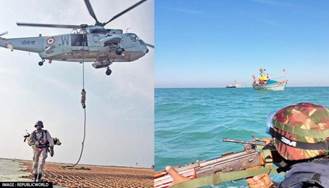
Disclaimer: Copyright infringement not intended.
Context
- The third edition of the Pan-India Coastal Defence Exercise Sea Vigil-22 will commence. The exercise will be undertaken along the entire seven thousand 516 kilometer coastline and the Exclusive Economic Zone of India. It will involve all the Coastal States and Union territories.
- The two-day exercise is being conducted by the Indian Navy in coordination with the Coast Guard and other ministries entrusted with the task of maritime activities.
The Exercise
- Exercise Sea Vigil was conceptualised in 2018 to validate various measures that have been instituted towards enhancing maritime security since the 26/11 terror attack.
- The exercise is a build up towards the major Theatre-level exercise TROPEX (Theatre-level Readiness Operational Exercise)” conducted by the Navy every two years.
- “Sea Vigil and TROPEX together will cover the entire spectrum of maritime security challenges, including transition from peace to conflict.
Significance
- Sea Vigil will provide a realistic assessment of our strengths and weaknesses and thus will help in further strengthening maritime and national security.
https://newsonair.gov.in/News?title=Third-edition-of-Pan-India-Coastal-Defence-Exercise-Sea-Vigil-22-to-commence-tomorrow&id=450866
Statehood to Uttarakhand
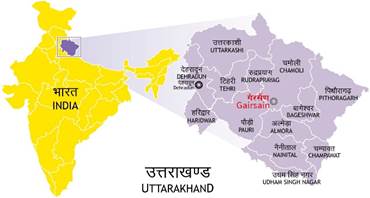
Disclaimer: Copyright infringement not intended.
Context
- Prime Minister Narendra Modi has greeted the people of Uttarakhand on their Statehood Day.
Details
- The Uttarakhand movement refers to the events of statehood activism within the undivided state of Uttar Pradesh which ultimately resulted in the formation of Uttarakhand, India as a separate state. Uttarakhand became a state on 9 November 2000. The formation of Uttarakhand was achieved after a long struggle and many sacrifices.
- The demand to make Uttarakhand a state was first raised at a special session of the Indian National Congress held in Srinagar on 5-6 May 1938. The demand gradually strengthened following a series of events. In 1994, the demand for a separate state eventually took the form of mass movement that resulted in the formation of India's 27th state by 2000.
https://newsonair.gov.in/News?title=PM-Modi-greets-people-of-Uttarakhand-on-their-Statehood-Day&id=450604








.jpg)


